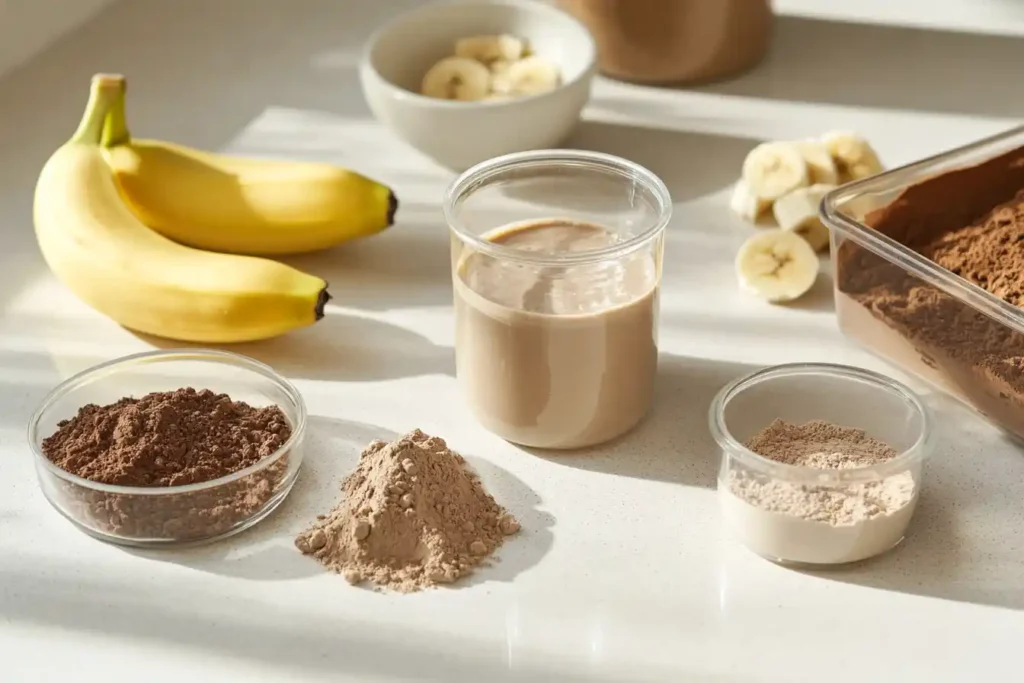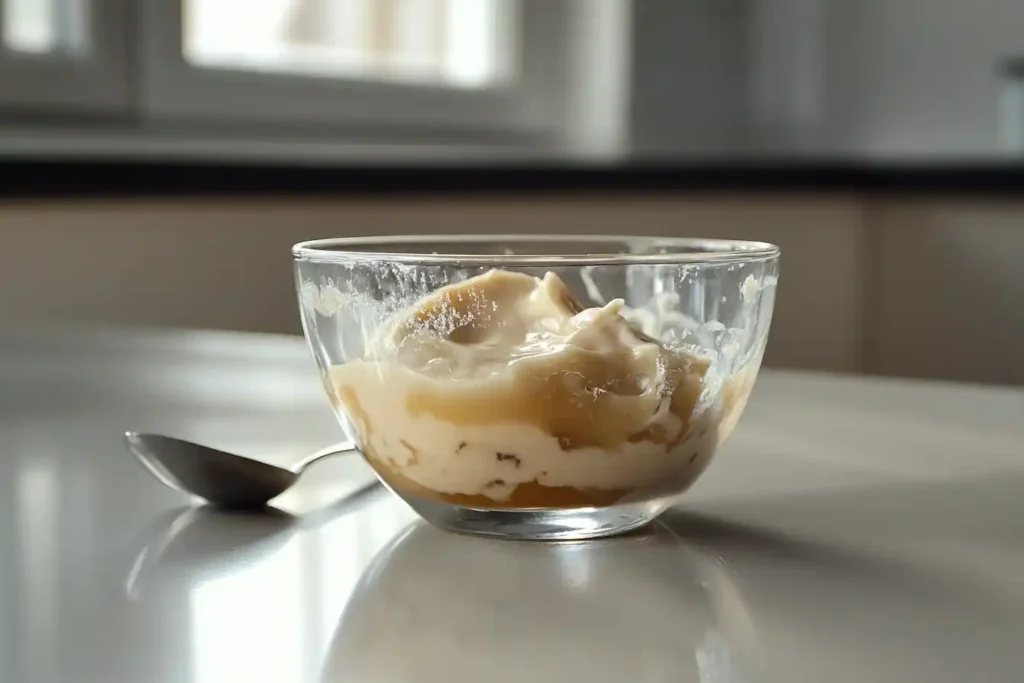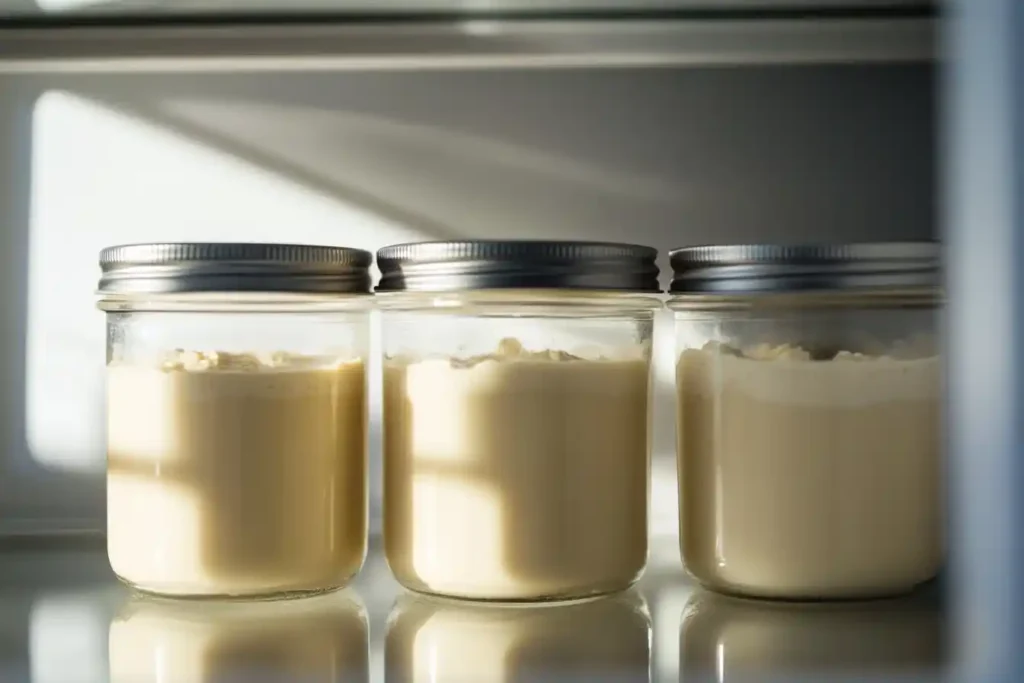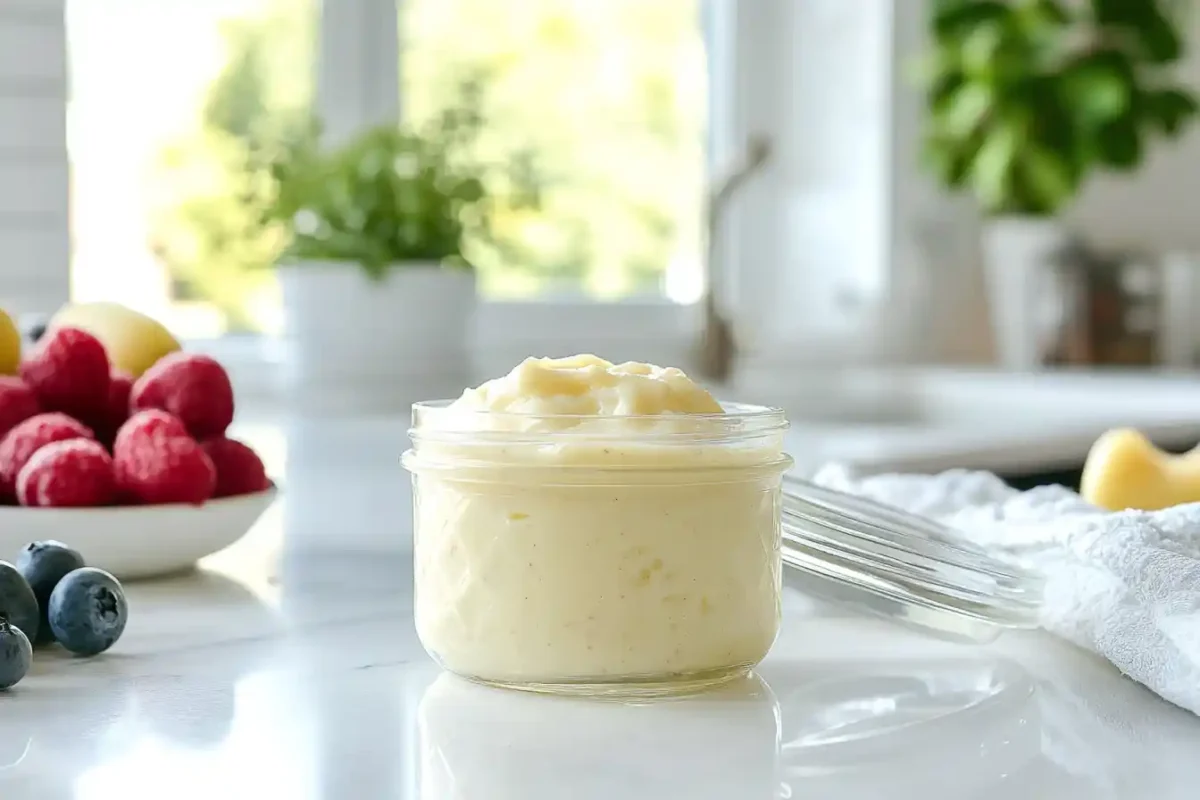Understanding Protein Pudding
What Is Protein Pudding?
Protein pudding is a creamy, nutritious dessert made by combining protein powder with milk, non-dairy alternatives, or yogurt, as shown in this protein pudding recipe. It’s popular among fitness enthusiasts and anyone seeking a tasty way to boost their protein intake. The texture is thick and velvety, resembling regular pudding but with a nutritional twist.
Typically, protein pudding can be customized with flavors like chocolate, vanilla, or fruit blends. It’s often enjoyed as a post-workout snack or a guilt-free dessert.
Nutritional Information for Protein Pudding (Per 100g Serving)
| Nutrient | Amount (per 100g) |
|---|---|
| Calories | 120 kcal |
| Protein | 15g |
| Carbohydrates | 6g |
| Sugars | 2g |
| Fat | 4g |
| Saturated Fat | 1g |
| Fiber | 1g |
| Sodium | 120mg |
Popularity and Uses in Diets
Why is protein pudding such a hit? For starters, it’s incredibly versatile. You can:
- Enjoy it as a quick breakfast alongside fresh berries.
- Use it as a pre- or post-workout treat to fuel your body.
- Turn it into a high-protein topping for oats or smoothies.
From bodybuilders to casual dieters, many people prefer protein pudding because it feels indulgent while helping them meet their nutritional goals. Plus, it’s easy to store in individual containers, making it a convenient grab-and-go snack.
However, convenience doesn’t mean we can overlook proper storage! Protein-rich foods can spoil quickly without the right care. So, how long does protein pudding really last in the fridge? Stay tuned as we uncover the facts in the next section!
Shelf Life of Protein Pudding
Determining the Shelf Life
Protein pudding may look like a simple dessert, but its shelf life depends on several key factors. Understanding these factors can help you keep your pudding fresh and safe to eat. Whether you’re working with a store-bought version or a homemade recipe, storing it correctly makes all the difference.
Let’s take a closer look at the elements that influence how long your protein pudding lasts in the fridge.
Factors Influencing Shelf Life

Ingredients Used
The type of ingredients in protein pudding significantly impacts its freshness.
- Milk-based recipes: These tend to spoil faster, especially if made with fresh dairy products like milk or cream.
- Non-dairy alternatives: Using almond milk, coconut milk, or oat milk can slightly extend shelf life due to their lower perishability.
- Protein powder: The quality of the protein powder also plays a role. Whey protein blends may behave differently compared to plant-based powders.
When fresh fruits or toppings like peanut butter are added, the pudding may spoil faster, as fruits release moisture that can alter the texture and encourage bacterial growth.
Preparation Methods
How you make your pudding also matters! If your mixing tools or storage containers aren’t properly sanitized, bacteria can easily transfer, causing the pudding to spoil quickly.
- Hot vs. cold preparation: If the recipe involves heating, it can help kill bacteria, but once cooled, the pudding must be refrigerated immediately.
- Batch vs. single servings: Large batches stored improperly can develop uneven cooling, creating hot spots where bacteria grow faster.
Storage Conditions
Your fridge setup can also influence shelf life.
- Ensure the fridge temperature stays at or below 4°C (39°F).
- Avoid placing the pudding near the door where temperature fluctuations occur.
- Use an airtight container to reduce air exposure, which can lead to oxidation and spoilage.
General Guidelines for Refrigeration
Store-Bought vs. Homemade Protein Pudding
Store-bought protein pudding often contains preservatives to extend shelf life, lasting up to 5–7 days in the fridge after opening, depending on the brand’s recommendation. Homemade protein pudding, however, typically lasts 2–4 days because it doesn’t contain added preservatives.
Recommended Refrigeration Duration
- Homemade pudding: Store it in a sealed, airtight container and consume within 2–3 days for the best taste and safety.
- Store-bought pudding: After opening, refrigerate and follow the expiration date on the label. However, if it’s unopened, it can last up to several weeks when kept in a cool fridge.
By following these simple guidelines, you can avoid the disappointment of spoiled pudding and get the most out of your protein-packed treat! And remember, factors like temperature, ingredient choices, and preparation all work together to determine its freshness.
Signs of Spoilage
Identifying Spoiled Protein Pudding

Nobody wants to bite into a dessert only to realize it’s gone bad—yikes! Knowing the warning signs of spoiled protein pudding can save you from an unpleasant experience (or worse, an upset stomach). Since protein-rich foods are more prone to spoilage, spotting the red flags early is essential. Here’s how to tell when your pudding has reached the end of its shelf life.
Visual Indicators
Mold Growth
One of the clearest signs of spoilage is mold.
- Look for green, white, or black fuzzy patches on the surface of the pudding.
- Mold tends to form more quickly if the pudding has been exposed to air or if it contains fresh fruits.
Even a small amount of visible mold means the entire batch is unsafe to eat. Discard it immediately—there’s no “scraping off” the top layer to save the rest!
Separation of Ingredients
- A watery layer forming on top of your pudding can indicate that it’s starting to break down.
- While slight separation is normal for some recipes (especially if using Greek yogurt or non-dairy milk), excessive separation often means the proteins and fats are degrading.
If you stir it and it still doesn’t return to its original consistency, it’s better to be safe and toss it.
Changes in Texture and Consistency
Protein pudding is supposed to be smooth and creamy.
- If the texture has turned grainy, slimy, or clumpy, that’s a telltale sign of spoilage.
- A gritty texture may also occur if the protein powder starts to congeal or break down due to bacterial growth.
Essentially, if it doesn’t “feel” right when you spoon it, it’s likely gone bad.
Off-Putting Odors
- A fresh batch of pudding should have a neutral or sweet smell, depending on the flavor.
- If you detect a sour, tangy, or rotten smell, it’s time to throw it away. Spoiled dairy-based pudding, in particular, gives off a strong sour odor as the milk proteins break down.
Your nose is one of your best tools—when in doubt, give it a sniff test!
By keeping an eye (and nose) out for these signs, you can avoid the disappointment of discovering that your favorite treat is no longer edible. Next up: let’s learn how to store protein pudding properly so it stays fresher for longer!
Proper Storage Techniques

Best Practices for Storing Protein Pudding
If you want to make the most of your protein pudding and enjoy it at its freshest, proper storage is key. Even a small mistake—like using the wrong container or storing it at the wrong temperature—can shorten its shelf life significantly. The good news? By following these simple storage techniques, you can keep your pudding creamy and safe for several days.
Ideal Refrigeration Temperature
The right temperature plays a crucial role in keeping protein pudding fresh.
- Set your refrigerator to 4°C (39°F) or lower, as this temperature slows down bacterial growth.
- Avoid frequent temperature changes by keeping the pudding away from the fridge door, where fluctuations occur due to opening and closing.
- If you’re using a fridge thermometer, check regularly to ensure the temperature stays consistent.
Tip: A colder fridge is better than a fluctuating one—consistency is key to maintaining freshness.
Appropriate Containers for Storage
Using the right container can make a big difference when it comes to the shelf life of protein pudding.
- Airtight containers: These are ideal for reducing air exposure and preventing moisture buildup, which can cause separation or bacterial contamination.
- Glass vs. plastic: Glass containers are preferable as they don’t absorb odors or stains, but BPA-free plastic containers work well too if sealed tightly.
- Single-serve containers: Storing pudding in individual portions helps you avoid unnecessary exposure when opening the container multiple times.
Pro tip: Mason jars or small reusable meal-prep containers make fantastic options for protein pudding storage!
Importance of Sealing and Air Exposure
Air is one of the biggest culprits behind spoiled protein pudding. When exposed to oxygen:
- The fats in the pudding can oxidize, leading to off-flavors.
- Bacteria have a better chance to multiply, especially if the pudding wasn’t made in sterile conditions.
Make sure to:
- Use containers with snug-fitting lids or secure covers with plastic wrap if needed.
- Minimize how long the container is open during serving to avoid prolonged air exposure.
Following these storage tips will keep your pudding fresh and smooth—and, let’s face it, who wouldn’t want that? Properly stored pudding doesn’t just taste better; it also helps you avoid food waste and unnecessary trips to the store!
Extending Shelf Life
Tips to Prolong Freshness
Want your protein pudding to last longer without sacrificing its creamy texture or nutritional benefits? You’re in luck! With a few simple tricks, you can extend the shelf life of your pudding and enjoy it for days (or even weeks) without worrying about spoilage. Let’s dive into some effective methods to keep your protein-packed treat fresh and tasty.
Utilizing Preservatives
Preservatives may sound like a chemical no-no, but certain natural preservatives can safely extend the life of your protein pudding.
- Citrus juice: A small splash of lemon or lime juice can help slow down bacterial growth thanks to its natural acidity.
- Salt: A tiny pinch of salt (especially if you’re making a chocolate or caramel-flavored pudding) can act as a preservative while enhancing flavor.
Most store-bought protein puddings already contain mild preservatives like potassium sorbate or ascorbic acid, which is why they often last longer than homemade versions. But with a little creativity, you can extend your homemade batch too!
Incorporating Natural Antioxidants
Adding antioxidants can also help delay spoilage:
- Vitamin C powder: This not only preserves freshness but also adds a nutrient boost.
- Honey: Naturally antibacterial, honey can be a great addition to protein pudding, especially in vanilla or fruit-based recipes.
These ingredients slow down oxidation, keeping your pudding’s color, texture, and taste intact for longer.
Freezing Protein Pudding

One of the best ways to extend shelf life is to freeze your protein pudding. Here’s how:
- Portion it out: Freeze in small, airtight containers for convenience.
- Leave headspace: Make sure there’s a little room at the top of the container, as the pudding will expand when frozen.
- Thawing instructions: Let the pudding thaw in the fridge overnight instead of on the counter to prevent bacterial growth.
Pro tip: Freezing may slightly alter the texture, but a quick stir after thawing can bring back its smooth consistency. And hey, some people even enjoy eating their frozen protein pudding as a “pudding pop”!
By following these tips, you can make your pudding last longer without compromising taste or safety. In the next section, we’ll cover the potential health risks of eating spoiled protein pudding—and how to avoid any unpleasant surprises.
Health Implications of Consuming Spoiled Protein Pudding
Risks Associated with Spoiled Dairy Products
Eating spoiled protein pudding can lead to more than just an unpleasant taste—it can cause serious health issues. Protein pudding often contains dairy or other perishable ingredients that, when spoiled, can become breeding grounds for harmful bacteria. Let’s explore the risks associated with consuming expired or improperly stored pudding and what to watch out for.
Foodborne Illnesses
Spoiled protein pudding can harbor bacteria like Salmonella, E. coli, or Listeria, especially if it contains milk, cream, or eggs. These bacteria can cause foodborne illnesses, leading to a range of digestive issues.
Some common problems associated with spoiled dairy-based desserts include:
- Food poisoning: Triggered by harmful bacteria that multiply in spoiled food.
- Stomach infections: Resulting from ingesting dangerous microorganisms that the immune system struggles to fight.
Even plant-based protein puddings made with nut or oat milk can spoil, though they’re less prone to certain bacterial contaminations.
Symptoms to Watch For
If you’ve eaten spoiled protein pudding, you may experience symptoms such as:
- Nausea or vomiting
- Stomach cramps or pain
- Diarrhea
- Fever and chills
- Fatigue or weakness
These symptoms can appear within a few hours of consumption or even a day later. While mild cases can resolve on their own with hydration and rest, severe symptoms should not be ignored.
When to Seek Medical Attention
Seek medical help if:
- You experience persistent vomiting and can’t keep fluids down.
- Diarrhea lasts more than 48 hours or contains blood.
- You have a high fever that doesn’t subside with over-the-counter medication.
- There are signs of severe dehydration (dizziness, dry mouth, or reduced urination).
It’s always better to err on the side of caution. Spoiled food can be more dangerous for children, the elderly, pregnant individuals, or those with weakened immune systems.
By paying attention to storage practices and spoilage signs, you can avoid the health risks that come with eating expired pudding. Now, let’s move on to some of the most common questions people ask about protein pudding storage and shelf life.
Frequently Asked Questions About Protein Pudding Storage and Shelf Life
Homemade protein pudding usually lasts 2–4 days in the fridge if stored properly in an airtight container, but you might wonder are protein puddings healthy beyond their shelf life.This short shelf life is due to the lack of preservatives found in store-bought versions. If you’ve added fresh fruits or toppings, it’s best to consume the pudding within 2 days, as fruits can release moisture and speed up spoilage.
The best containers for storing protein pudding are:
Glass containers with airtight lids: These prevent odors and don’t stain.
BPA-free plastic containers: Lightweight and portable, ideal for meal prepping.
Mason jars: These are great for single servings and keep air exposure minimal.
Avoid loosely covered bowls or foil wraps, as they can let in too much air and lead to faster spoilage.
No, it’s not safe to eat protein pudding that has been left out at room temperature for more than 2 hours. At temperatures above 40°F (4°C), bacteria can multiply quickly. This is especially true for dairy-based puddings. If you accidentally leave it out overnight, it’s better to discard it rather than risk food poisoning.
You can tell your pudding has spoiled if:
It has an unusual sour or rancid smell.
There is visible mold or discoloration on the surface.
The texture is watery, grainy, or slimy.
It tastes off or overly tangy.
If any of these signs are present, don’t take any chances—throw it away.
Conclusion Of Protein Pudding Storage and Shelf Life
Protein pudding is a versatile and delicious treat, but it requires proper care to stay fresh and safe to eat. Understanding how long protein pudding lasts in the fridge depends on factors like ingredients, preparation methods, and storage conditions. Homemade versions typically last 2–4 days, while store-bought options can last longer due to added preservatives.
By using airtight containers, storing your pudding at the right temperature, and watching for spoilage signs—like mold, off-putting odors, and texture changes—you can avoid food waste and potential health risks. If you want to extend its shelf life even further, freezing is a great option, though you may need to stir it after thawing.
Ultimately, paying attention to storage practices not only helps maintain the pudding’s creamy texture and rich flavor but also keeps you and your family safe from foodborne illnesses. Follow these tips, and you’ll enjoy every spoonful without worry!

